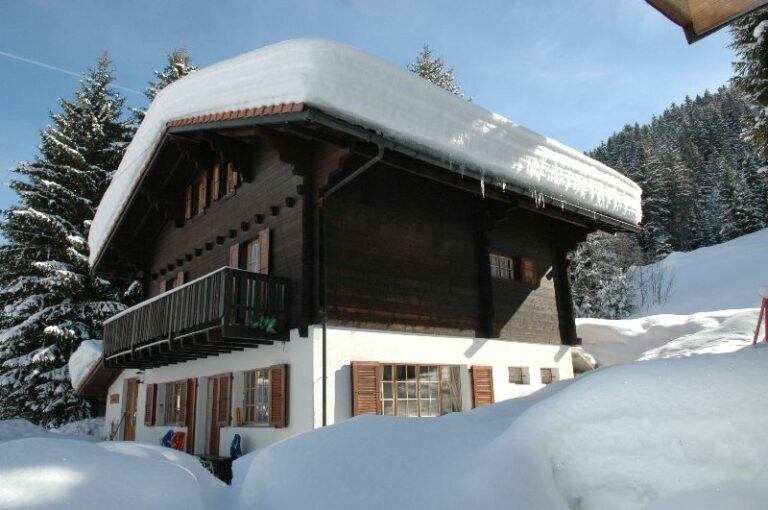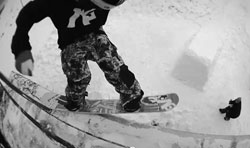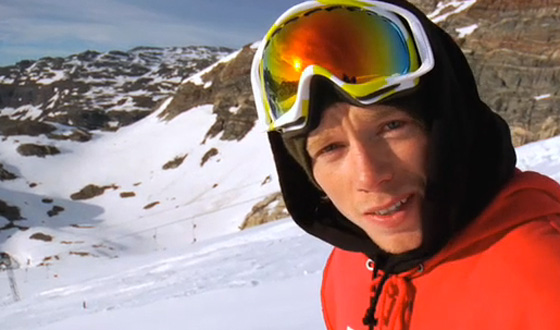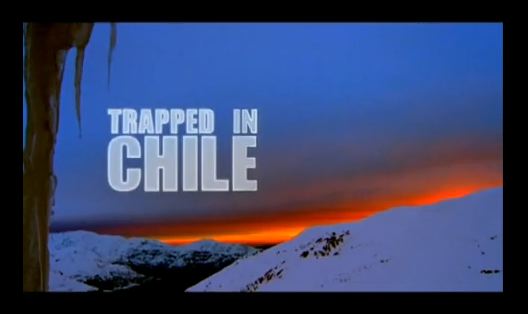
From Issue 88 of Whitelines Magazine
Words: Ed
Photos: Matt Georges
Snow falls softly down through the night air, like a million feather pillows have burst somewhere up in the darkness. It settles on the piste and drifts against the lift pylons. It covers the delicate branches of the trees. I brush a fresh layer of crystals from my goggle lens and look through a galaxy of swirling snowflakes at my friends, who are digging a jump in the glare of a floodlight. Dozens of these eerie yellow lamps dot the valleys and forests of the mountainside. The kicker has some way to go before it’s ready to be hit, and since I’m not here to star in the photos anyway, I figure I’ve got time for another lap. I heave the nose of my board clear of the powder and set off alone down the silent cat track, sending up plumes of cold smoke in my wake. It’s late, and my mind is wandering towards a bowl of steaming noodles.
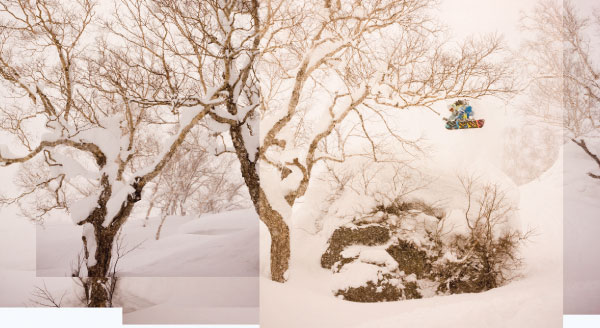
People say that visiting Japan is the closest you can get to flying to a different planet, and at times like these it definitely has a surreal, otherworldly quality. For snowboarders, it is a dream destination – one to tick off the ‘places to ride before I die’ list. Japan’s place in snowboarding folklore was secured during the late 80s and early 90s, when a number of pioneering American film crews discovered a land of friendly people, strange food and – most importantly of all – bottomless freshies. Even better, the beautiful powder slopes were largely empty. “It was weird being in place where they just don’t ride the trees,” raved former pro Jay Nelson back in 1994, “The locals said that the spirits lived in the trees. We all thought, ‘Well, y’know, the best snow is in the trees, so that’s where we’ll be!’” As it happens, what Jay heard about the spirits wasn’t totally true, and today you’ll find plenty of Japanese snowboarders ripping up tree lines, but that didn’t matter at the time because everyone believed him. And of course the footage of him and his American friends ploughing their rental car through 8ft drifts on the side of the road spoke for itself. Word was out: Japan was paradise.
In the years since, Japan has been filmed, photographed and written about more than almost any other snowboard destination. Like the perfect waves of Indonesia – once a hidden gem explored by hardy surf travellers of the 1970s, now a mainstream tourist trap – its reputation for great snow has seen more and more foreigners arrive on its shores, chasing the powder dream. Like Indo, moreover, the global invasion has been led by the Australians, for whom Japan is a closer winter option than Europe or North America. We were here to chase our own dream. Would the reality stack up to the myth, or are the famous peaks of Hokkaido a case of paradise lost?
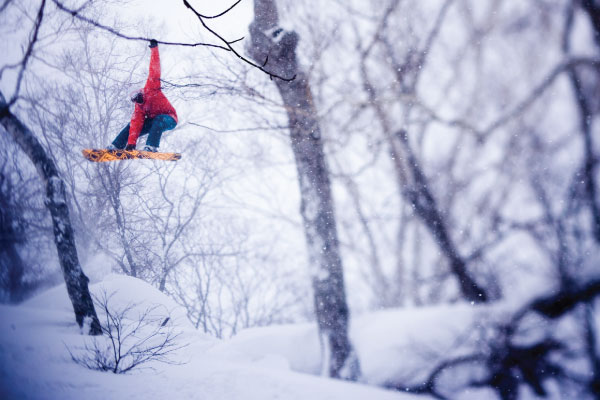
Niseko
Back in our apartment building, the elevator gently chimes to announce our floor. Everything in Japan chimes. Chairlifts give a polite ‘ding dong’ each time the gate opens, ATM machines sound bells like a fruit machine when your money is dispensed, car dashboards are veritable cacophony of beeps and gongs. Yup, Japan certainly lives up to its reputation for bizarre high tech gadgetry. The apartment we’re staying in even has one of those electronic toilets with various buttons on the side for heating the seat and spraying yourself clean.
Josh Wolf returns from the bathroom. “Watch out for the fanny spray button,” he says, “It tickles your balls!”
Josh – long haired like Geoffrey Lebowski and similarly laid back – is one of four riders on this trip. He is joined from the UK by granite-jawed jock Scott McMorris and the albino Yorkshireman Colum Mytton. There’s a multicultural aspect to this Whitelines tour, however, with French photographer Matt Georges manning a variety of cameras (Digital SLRs, pocket point-and-shoots, vintage Russian film cameras… Matt is more trigger happy than our Japanese hosts) and Swiss miss Anne-Flore Marxer crashing our little sausage party. Anne-Flore is one of the biggest names in the women’s snowboarding, and the only one in our group who has been to Japan before. She has a fearless, bubbly character, and while the rest of us are scared to attempt the most basic Japanese she has been getting straight in there with a pocket phrase book and a wide smile. It seems to work wonders. She certainly sounds authentic to me.
“The trick is you don’t really have to know much Japanese at all,” she tells me. “Like, I know how to say ‘hello’ – konnichiwa – and ‘thank you very much’ – arigatou gozaimasu – but the rest of the stuff you can kind of make up.”
“How do you mean, make it up?!”
“Me and David Benedek were in Tokyo one time, and we were trying to find our way to the fish market. No one could understand what we were saying. Then David goes, ‘Fish-a market-ooh’ in this Japanese accent and they got it straight away. You just have to speak like they do – and add ‘ooh’ onto the end of everything.”
Weirdly, Anne-Flore’s technique seems to work! I am now fluent at asking for a salad-ooh, or a receipt-ooh. As for Colum, I’m not so sure even her one-word Japanese language school can make his Yorkshire accent any more intelligible to the locals. His version of moshi-moshi (the traditional local phone greeting) sounds more like he’s in a Halifax chippy ordering mushy peas twice.
Going somewhere with such a dramatically different language is definitely one of the funnest things about this country. As the rest of us channel hop through the strange news stations and gameshows on the television, Scott returns from a mission to the shop and hits the buzzer. I answer the intercom in a fake Mr Miagi voice, watching his face in the tiny fisheye TV screen. He frowns. I make more random Japanese sounds and watch first confusion, then embarrassment creep over Scott’s face. “Sorry, wrong number, er… arigato” he stammers, and I burst out laughing.
“You bastard!”
The mood is good. It has been all the way from Heathrow. No two ways about it, boarding a flight to the Orient is cool. Most of the time you go to an airport it’s to visit somewhere mundane and European; when you see the word ‘Tokyo’ beside your flight number on the departure board, it conjures a romantic thrill of excitement. You feel like James Bond en route to tackle super-villains in volcanoes. The little differences on the plane help set the mood too – the Japanese hostesses, the sing-song translation of the safety demonstration, the neat lacquered boxes of sushi in place of a foil-topped meal. If there’s one thing the Japanese do well, it’s neatness. Just look at the country itself – 127 million people efficiently squeezed into a set of islands little bigger than the UK. No wonder they’re so good with microchips. From immigration forms to media applications, everything is orderly and meticulously inspected, and since arriving in resort we have constantly been left amazed by obsessive little pieces of categorization, like the perfectly arranged nail scrubbers in the bathroom or the plastic carton of used ring pulls outside one of the mountain restaurants. Are they for recycling? Who knows.
Niseko is the legendary powder capital of the country, situated in the tail of the northern island of Hokkaido. For years it was a small, remote ski resort that barely registered on the international radar, but thanks to riders like Nicolas Müller (who regularly films here for the Absinthe movies) it now attracts an army of powder hunters. Niseko’s ever-increasing popularity means new bars, shops and hotels are springing up throughout the town on a regular basis, while property prices have gone through the roof. The terrain itself is actually pretty unspectacular by European standards – a series of low, rolling hills which straddle the main town of Hirafu and its two neighbouring villages, Higashiyama and Annapuri. What Niseko lacks in long, Chamonix-esque descents, however, it makes up for in sheer snowfall. The magic starts in Siberia, where bone-chillingly cold low pressure systems are born. Prevailing westerly winds carry these storms across the Sea of Japan towards Hokkaido, where they gather moisture before hitting the mountains and dumping a bounty of dry flakes – known to the locals as yuki. In short, Niseko is the sharp end of a powder-making machine. With so much of the stuff covering cliffs, rocks and tree stumps – and avalanche danger moderate within the confines of the forest – the relatively mellow terrain becomes a playground in which Müller-esque creativity knows no bounds. The flipside of all this, of course, is frequent flat light. Japan is known as one of the hardest places in the world for photographers to shoot, and so far on this trip the clouds have parted long enough for just one fleeting glimpse of the giant volcano which lies a few miles to the southeast. I’m glad I packed a spare goggle lens.
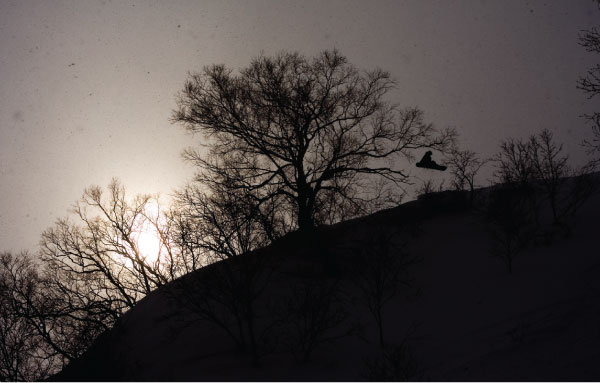
It is midway through our stay in Niseko, and despite a little drizzle at the start of the week (be warned, even Japan can get rain) conditions are now ideal. I am charging through well-spaced trees between the pistes, chasing my friends’ rooster tails and dropping down pillows. I am Nicolas Müller. My face is freezing, though. It sounds stupid but I hadn’t expected it to be so cold. I guess that’s the payoff for Siberian weather fronts. As a result the whole team is bandana’d or face-masked up. My own protection of choice is a bright orange balaclava I picked up from an Army & Navy store in Seattle, which makes me look like a conspicuous IRA gunman. It is clustered in ice.
We have settled into a routine of powder for breakfast, powder for lunch, and powder for dinner – the latter enjoyed under the resort’s powerful floodlights. Night riding has proved to be the highlight of the trip – better, even, than our day of catboarding, in which a bearded kiwi named Cameron squeezed us into an antique piste basher and chugged us noisily up to a remote ridge 10 miles out of town. OK, the snow up there was deeper and drier than anything I had experienced in 15 years of riding, and the pillows were the stuff of snowboarding fantasy, but with no plough on the front of the tired old snowcat, shuttle runs were out of the question. We therefore spent a memorable five hours hiking through chest deep yuki. In contrast, we’ve found the night sessions here in resort much more productive – and to be honest, not a whole lot more crowded. While it’s true that these days you won’t have the lifts to yourself (on any given run under the ropes you’re likely to cross paths with an aussie or Japanese shred dog) most of the punters head home around four o’clock, leaving the slopes wonderfully empty as the floodlights are switched on. What makes it even more special is that almost the whole mountain remains open – not just a piste or two as the norm elsewhere in the world. Throw in yet more fresh powder and the experience is unreal… Under cover of darkness, Niseko becomes a weird moonscape, snowboarding a stealth art form. We dart between pools of light and inky forests, surf down shadowy snowbanks and carve down the sepia groomers at 50mph as flurries of flakes whip past the giant lamps. The efficient lift crew keep things going until 9pm, politely brushing snow off the chairs with an old fashioned broom.
When it’s finally time to come off the hill, Niseko offers a variety of interesting places to eat. Tonight we are in our favourite little noodle bar in the centre of Hirafu. It is no bigger than a large living room, with a mixture of bar stool seating and tables and benches. We don’t know what the place is called – the words on the steamed-up window are in mysterious kanji characters – but we’ve learned that the food is good, and cheap. In a small, open plan kitchen on the far side of the bartop, two guys with Karate Kid style bands in their hair chop veg and flash fry noodles in a scorching wok. They are overseen by a woman they introduce as “Mama-San”, a sixty year-old with a heavy bosom who brings us giant bowls of chicken and noodles swimming in miso soup. Whether she’s actually their real mother is anyone’s guess, but she’s certainly the boss of this house. Wolfie is disappointed tonight, however. His yaki-udon has arrived – a traditional dish made with fat, worm-like noodles and no soup. He is staring in horror at the wafer thin slices of fish on the top. “Ah, man, I hate fish!” Wolfie loves his food, especially after a hard night’s shredding, so this is a spirit-crushing development. Then the unthinkable happens. The slices of fish begin to wriggle and move on their bed of noodles. “Fuck! It’s still alive!” he screams. It is too – the flakes are actually writhing around in what looks to be their last death throes. I recall a story someone told me about a trip to China, when a whole, live flounder was sliced in half and served immediately as raw sushi – only to give a final shudder as he leaned over it with his chopsticks. I look back at Wolfie’s plate and realize our mistake: “It’s not alive, dude, it’s wafer thin and the heat is making it curl.”
“Well it’s still fish and I fuckin’ hate fish.”
The bill is a reasonable six pounds each or so. Japan has a reputation as one of the most expensive countries anywhere to visit, but until this year it was actually similar to the UK or France (once you’ve forked out for the airfare). Unfortunately for us, we’ve chosen to visit during the height of the credit crunch, when the pound is being royally taken in the ass by pretty much every currency on the planet – not least the yen. We’re all feeling the pinch, but noodles are always a cheap option and since this is a ‘dream trip’ no one is complaining. Bottom line is, snowboarding anywhere is expensive right now, and the night riding alone has made this trip worth it.
For those Brits who decide to stay in Japan for longer, you really need to find a job to help pay the rent. Short of living in a campervan (which is exactly what a whole crew of Japanese shredders do, having opted out of the rat race) this isn’t the kind of place you can realistically bum a season. Most of the UK seasonaires we’ve met out here, including our guide Ben Thorpe from Japan Ski Experience, are more entrepreneurial. Unlike your Chamonix chalet boy with his English friends and jars of Marmite in the cupboard, Ben has learned the language (starting out teaching English to high school kids) made friends with local snowboarders and generally learned to respect the local culture. That said, there are other roads to the ex-pat lifestyle. In Niseko’s Wild Bills bar – a Tex-Mex melting pot of powder-loving Japanese and foreigners (‘gaijin’) – we meet Welshman Owain Bassett, brother of Tignes’ Dragon Lodge founder John. Owain married a Japanese woman and emigrated out here a couple of years ago, building himself a beautiful, semi-traditional house in the forest outside Niseko.
“What do you do for money?” I ask him.
“I sold my share of the original Dragon Lodge and I’ve just been so busy with the house I haven’t really been working,” he replies. “But I have pretty modest spending habits, and I don’t come into town all that much – I just live in the woods! We’ve even drilled our own water well so bills are low.”
Before leaving resort, Ben takes us to a detached chalet-like building on the edge of town. It is the showroom for a local snowboard company called Gentemstick. We remove our shoes and step into a spotless wooden shop floor. High on one wall is a collection of classic snowboards, including vintage swallowtails from 80s brand Winterstick. On the other wall are a handful of custom-shaped fibreglass surfboards. The room is reverentially quiet, like a church. Gentemstick’s own range of hand-crafted snowboards sits in a neat rack on the last wall, beneath soft spotlights. They specialize in creating outrageously shaped powder boards with fat noses and tapered tails – perfect for tackling the unique powder conditions of Japan. We are here to visit the company’s founder and owner, Taro Tamai. Ben conducts a whispered conversation with the young guy on the shopfloor, who disappears behind a bead curtain. The seven of us are left gazing around the room in silence, hesitant to touch anything. After several long minutes, Taro emerges. He is wearing a peaked beanie and jeans like any snowboarder, yet his face has a serious quality – like an artist stood before his work. Ben speaks a few words in Japanese, and invites me to present my business card. Business cards, I’ve learned, are an important token in Japan. I hold mine between both hands and bow slightly; Taro mirrors the gesture and takes it in both his. He then takes a stool across from us and, with Ben as interpreter, conducts a formal Q & A session. It is clear that he takes the business of making snowboards seriously. Not for Gentemstick the wacky banana marketing of certain American brands, or loud attention-seeking graphics. To Taro, his boards are more like beautiful, custom surfboards. It is as if he has taken the craft and philosophy of surfing, mixed it with the spirituality of powder riding and added a dash of traditional Japanese business practice. It is a lesson in the way that, while Japanese kids love to dress wild and embrace western trends, they do it in their own way. In a nutshell, they take it all rather seriously. That might seem strange for something as essentially unimportant as powder riding, but Taro’s earnestness is what makes his boards so special and unusual. They’re not snowboards – they’re samurai swords! We leave the place impressed, and a little dazed.
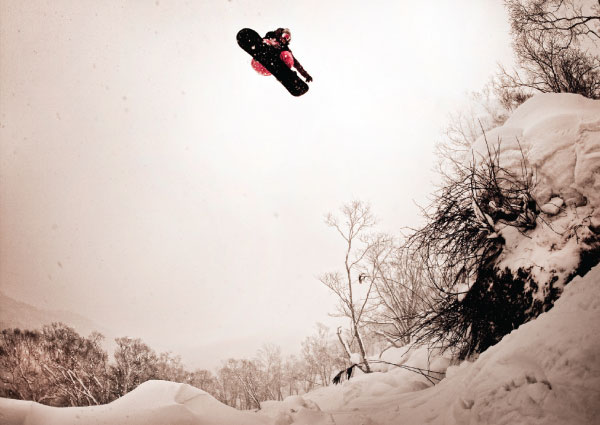
Hakuba
Our trip is split between the Niseko (on Hokkaido) and Hakuba, a large valley on the main island of Honshu which connects no fewer than 10 resorts in the Japanese Alps. Chaos reigns at the train station in Niseko. We have arrived late, and the envoy from the local tourist office – who are helping arrange tickets – is having a heart attack. There is less than five minutes until our train departs, and all six of us need to pay for a complex ticket which costs over a hundred pounds. To make things worse, no-one’s credit card is working. The woman is positively freaking out now. Our timetable doesn’t allow any margin for error, and if we can count on one thing, it’s that our train won’t be late. In Japan, the trains are never late. Well, that’s not strictly true, because in 2006 – come rain, wind and snow – the Shinkansen (bullet train) was delayed by an average of, er… 20 seconds. Fortunately Anne-Flore Marxer has withdrawn a ludicrous amount of cash and slaps it down on the counter to pay for all of us, and the next moment we are clattering over the footbridge dragging board bags and camera gear. The conductor, remarkably, holds the train for us. Did the woman from the tourist board have a word in someone’s ear? Either way we have blown their annual punctuality target in one fell swoop.
Several people on the carriage wear white surgical masks. This is a common sight in Japan – even here in the clear air of the mountains. Apparently, they do so not just to protect themselves from pollution, but out of respect for others. At the first sign of a cold or other illness, people in Japan don the masks in order to avoid coughing or sneezing germs onto strangers. It is a powerful symbol of the country’s neurotic yet incredibly polite culture. We pass the journey dozing, playing UNO or staring out at the wintry landscape. Colum is drinking hot coffee from a can – just another quirk of Japan’s obsession with vending machines – and it brings to mind a story a friend once told me when he came back from the country. His train had stopped in the middle of nowhere for a few minutes, and outside the window – in the middle of a field – was a vending machine!
The snow in Hakuba is usually as epic as anywhere in the world, but we are visiting during a poor season and conditions here on the main island are heavy. The terrain, however, is fantastic. Known as the Chamonix of Japan, Hakuba’s mountains are bigger and steeper than those of Niseko, and having successfully negotiated the railway system and boarded the gondola to the top we are impressed by the awesome view across weird, craggy peaks covered in matchstick-like trees. They look strangely like furry animals. Our guides are Andy and Sarah from ‘Snow Season Japan’ who, like Ben back in Niseko, have set up their own company specializing in taking Brits to Japan. The pair show us around two of the biggest resorts in the area: Hakuba 47 (named because it enjoys “4 seasons, 7 days a week”) and Happo One (pronounced Happo Oh-ney). Colum, Scott, Wolfie and Anne-Flore are well-skilled in the art of getting good photos in average snow. We spend a day or two hiking about the backcountry building kickers, then head to the park in Hakuba 47 where we enjoy man-made jumps for the first time in weeks. The locals love their freestyle, and the set-up here is as good as most places in Europe.
It’s a famous snowboarding fact that Japan has more ski resorts per person than any country in the world. Many consist of little more than a couple of lifts and a café, but if it’s powder and solitude you’re after then these micro-resorts are ideal. On our penultimate day, Andy takes us to one such example, Cortina. Walking to the chairlift, we pass a group of schoolkids who are learning snow-plow beneath an inflatable manga character. Anne-Flore smiles and gives them a peace sign; the kids throw back ‘Vs’ excitedly. “Saikou!” We shout, and they all giggle. Saikou is our new favourite word – it means ‘sick.’
At the summit, we follow Andy off the piste and into the forest. Quite simply, it is the best tree run I’ve ever ridden in my life – or at least it would be if the snow was a little lighter. The trunks are perfectly spaced at five metres or so, and the pitch is a solid thirty degrees, so we are able to open up the throttle and chase each other through the woods like speeder-bikes in Return of the Jedi.
Cortina’s base station is dominated by a giant fairytale hotel – something between a Disney cartoon castle and Michael Jackson’s house. It is a surreal place. Cold and soaked through after a few hours lapping the forest, we take the lift to an upper floor and visit the hotel’s traditional hot spring, or onsen. Onsens are a massive part of Japanese life, like baths were to the Romans. There’s a whole etiquette to the experience, beginning with: women and men bathe separately, and everyone goes naked. To save your modesty you are provided with a small towel little bigger than a fig leaf, though most of the locals don’t much worry about these. Us boys leave Anne-Flore to her solo bath and head into the mist of the men’s onsen, where strange guys are wandering brazenly between steaming hot pools. The women’s side is surely a more pleasant place to be, I think to myself. Most of us cling to our “dick towels” until we’re safely waist deep in the water (we’re friends, but we’re not that friendly) though French photographer Matt seems pretty comfortable with the whole thing. Colum Mytton, red faced in the heat, looks uncannily like one of the famous snow monkeys who bathe in an outdoor spring not far from near here, while Josh has wasted no time hiding my fig leaf and has disappeared back into the changing rooms.
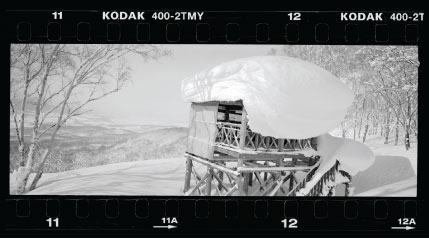
Tokyo
Outside my little capsule, the neon city hums to the rhythm of pachinko machines and traffic. Girls strut across zebra crossings in tiny plaid skirts, umbrella’d commuters emerge from metro stations , boys with shard-like hair stand smoking outside flashing arcades. Tokyo is as I imagined it to be: modern, weird, dense. We are staying in the cheapest accommodation in town – a capsule hotel on the edge of the electronic district. Popular with businessmen working late or rolling out of the bars at closing time, capsules are a very Japanese phenomenon. Shoes and baggage is left on the ground floor, a towel and toothbrush (with paste already applied) is picked up from a locker on the second floor, and you are assigned a honeycomb bed somewhere in the beehive of bunks which occupy the rest of the building. Each of the capsules has a TV and radio fitted into its plastic mould, like an HD-ready cocoon. Our own stay is made stranger still by the appearance of a South American film crew, who ask if they can shoot Josh Wolf entering his new digs for a segment on the Brazilian equivalent of The One Show. Apparently it will be watched by about 50 million people.
It is our final night in Japan, and having wandered for hours amongst the manga cafes and electronic superstores, we eat dinner near in one of the capital’s many incredible restaurants (Tokyo boasts more Michelin-starred eateries than Paris). We are being hosted by a French friend of Matt’s – now living in the city – and his two female friends, both Japanese. Wolfie is having another culinary nightmare, presented by a table full of mysterious fish dishes. In the centre is a dish of white, glistening worms.
“Try it, it’s fantastic. Really,” says Matt’s friend. “It’s a local delicacy.”
Wolfie shakes his head with a scowl. Scott and Colum pinch a corner each between their chopsticks and take a tentative bite.
“It’s a bit creamy,” says Col in his thick Yorkshire accent. “What is it?”
“Fish testicles.”
I look down through my scratched perspex window, as the clouds fold back over Japan for the final time. One of the cabin crew is approaching with a drinks trolley. She is Japanese herself, and as she pours the group some tea, she asks us what we did during our stay. We tell her we’ve been to the mountains of Niseko and Hakuba, and she nods her head enthusiastically.
“So did you like Japan?” she asks.
Well, did I like it? I think about how, like snowboarders the world over, I’ve dreamed of visiting the place for years – of chasing out spirits from powdery tree runs and blasting over mushroom pillows like Nicolas Müller. Now finally the dream has been realized. Did it live up to the hype?
I smile. “Yeah,” I say. “It was sick – Saikou!!”
The stewardess puts with her hand in front of her mouth and giggles girlishly.
“Heeheehee! Saikou!”

